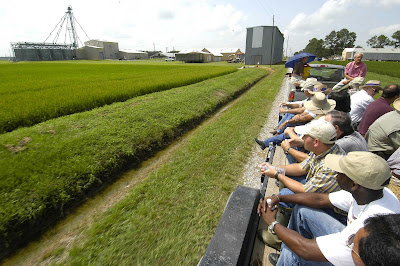
The Rice Research Station is the place to be June 28 for the annual Field Day.
In the above picture, LSU AgCenter county agents and Rice Research Station scientists ride by the blog field during preparations for the Field Day.
The day starts at 7:30 a.m. with field tours continuing until 9:30 a.m.
A poster session highlighting research and agricultural products will be held from 7:30 a.m. until 10:30 a.m. Dr. Johnny Saichuk, LSU AgCenter rice specialist, will be available to provide answers to questions about their crop. Farmers who have questions related to diseases, insects or weeds should bring samples.
The program starts at 10:45 a.m. with a review of Louisiana Rice Research Board activities by LRRB vice chairman Jackie Loewer. He will be followed by Johnny Broussard, USA Rice Federation legislative affairs director, who will give an update on the latest developments in congress related to the farm bill and how it could affect rice farmers.
Dr. Mike Salassi, LSU AgCenter economist, will discuss rice economics, and the program will end with remarks from Dr. Bill Richardson, LSU AgCenter chancellor.
The program starts at 10:45 a.m. with a review of Louisiana Rice Research Board activities by LRRB vice chairman Jackie Loewer. He will be followed by Johnny Broussard, USA Rice Federation legislative affairs director, who will give an update on the latest developments in congress related to the farm bill and how it could affect rice farmers.
Dr. Mike Salassi, LSU AgCenter economist, will discuss rice economics, and the program will end with remarks from Dr. Bill Richardson, LSU AgCenter chancellor.









